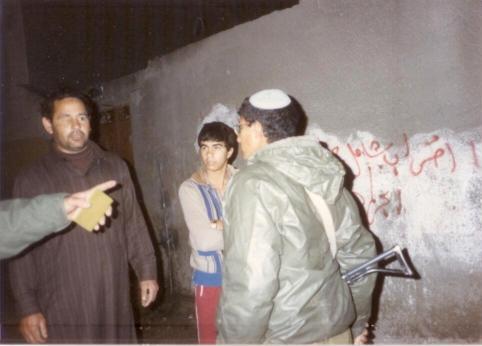Intifada, 1987-1993
Enlarge text Shrink text- LC data base, 12/10/90(Intifada, Intifāḍah, Palestinian uprising)
- World monitor, 1990:v. 3 (Intifada)
- Geographical review, 1990:v. 80 (Intifada)
- Middle East report, 1990:v. 20 (Intifada)
- American lawyer, 1990:v. 12 (Intifada)
- New York Times(Intifada, Palestinian uprising)
- Washington Post(Intifada, Palestinian uprising)
- Columbia human rights law review, 1990:v. 21 (Intifada)
- Ethics and international affairs, 1990:v. 4 (Intifada)
- Hennepin(Palestinian Uprising, 1987- )
- A quiet revolution : the first Palestinian Intifada and nonviolent resistance, c2007.
- Concise Oxford dict. of politics, 2003(Intifada: the first intifada arose spontaneously in 1987, lasting until 1993, and the second began in 2000)
This page is subject to the extended confirmed restriction related to the Arab-Israeli conflict. The First Intifada (Arabic: الانتفاضة الأولى, romanized: al-Intifāḍa al-’Ūlā, lit. 'The First Uprising'), also known as the First Palestinian Intifada, was a sustained series of non-violent protests, acts of civil disobedience and riots carried out by Palestinians in the Israeli-occupied Palestinian territories and Israel. It was motivated by collective Palestinian frustration over Israel's military occupation of the West Bank and the Gaza Strip as it approached a twenty-year mark, having begun in the wake of the 1967 Arab–Israeli War. The uprising lasted from December 1987 until the Madrid Conference of 1991, though some date its conclusion to 1993, the year the Oslo Accords were signed. The Intifada began on 9 December 1987 in the Jabalia refugee camp after an Israeli truck driver collided with parked civilian vehicles, killing four Palestinian workers, three of whom were from the refugee camp. Palestinians charged that the collision was a deliberate response for the killing of an Israeli in Gaza days earlier. Israel denied that the crash, which came at time of heightened tensions, was intentional or coordinated. The Palestinian response was characterized by protests, civil disobedience, and violence. There was graffiti, barricading, and widespread throwing of stones and Molotov cocktails at the Israeli army and its infrastructure within the West Bank and Gaza Strip. These contrasted with civil efforts including general strikes, boycotts of Israeli Civil Administration institutions in the Gaza Strip and the West Bank, an economic boycott consisting of refusal to work in Israeli settlements on Israeli products, refusal to pay taxes, and refusal to drive Palestinian cars with Israeli licenses. Israel deployed some 80,000 soldiers in response. Israeli countermeasures, which initially included the use of live rounds frequently in cases of riots, were criticized by Human Rights Watch as disproportionate, in addition to Israel's excessive use of lethal force. In the first 13 months, 332 Palestinians and 12 Israelis were killed. Images of soldiers beating adolescents with clubs then led to the adoption of firing semi-lethal plastic bullets. During the whole six-year intifada, the Israeli army killed at least 1,087 Palestinians, of which 240 were children. Among Israelis, 100 civilians and 60 Israeli soldiers were killed, often by militants outside the control of the Intifada's UNLU, and more than 1,400 Israeli civilians and 1,700 soldiers were injured. Intra-Palestinian violence was also a prominent feature of the Intifada, with widespread executions of an estimated 822 Palestinians killed as alleged Israeli collaborators (1988–April 1994). At the time Israel reportedly obtained information from some 18,000 Palestinians who had been compromised, although fewer than half had any proven contact with the Israeli authorities. The ensuing Second Intifada took place from September 2000 to 2005.
Read more on Wikipedia >
 Topic
Topic


.jpg)







